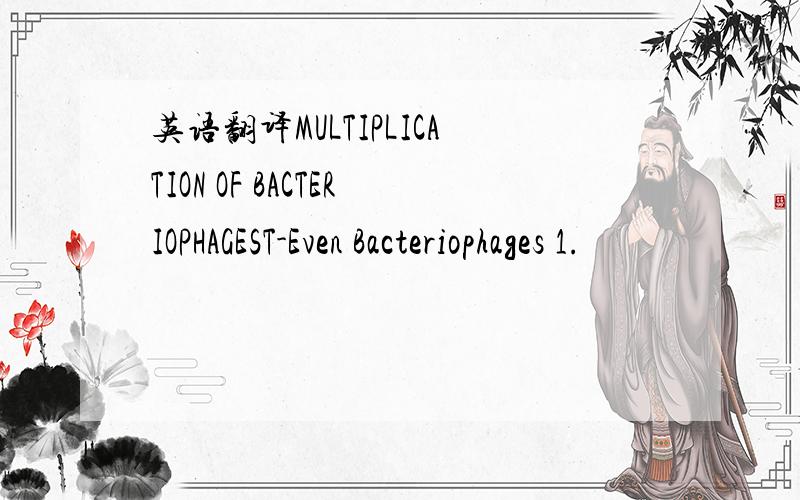英语翻译MULTIPLICATION OF BACTERIOPHAGEST-Even Bacteriophages 1.
来源:学生作业帮 编辑:神马作文网作业帮 分类:英语作业 时间:2024/11/20 03:48:03
英语翻译
MULTIPLICATION OF BACTERIOPHAGES
T-Even Bacteriophages
1.The T-even bacteriophages that infect E coli have been studied extensively.
2.In attachment,sites on the phage's tail fibers attach to
complementary receptor sites on the bacterial cell.
3.In penetration,phage lysozyme opens a portion of the
bacterial cell wall,the tail sheath contracts to force the tail
core through the cell wall,and phage DNA enters the bacterial
cell.The capsid remains outside.
4.In biosynthesis,transcription of phage DNA produces mRNA
coding for proteins necessary for phage multiplication.Phage DNA is replicated,and capsid proteins are produced.During the
eclipse period,separate phage DNA and protein can be found.
5.During maturation,phage DNA and capsids are assembled into
complete viruses.
6.During release,phage lysozyme breaks down the bacterial
cell wall,and the multiplied phages are released.
7.The time from phage adsorption to release is called burst
time (20 to 40 minutes).Burst size,the number of newly synthesized phages produced from a single infected cell,ranges
from 50 to 200.
Lysogeny
1.During a lytic cycle,a phage causes the lysis and death of
a host cell.
2.Some viruses can either cause lysis or have their DNA
incorporated as a prophage into the DNA of the host cell.The
latter situation is called lysogeny.
3.Prophage genes are regulated by a represser coded for by the
prophage.The prophage is replicated each time the cell divides.
4.Exposure to certain mutagens can lead to excision of the prophage and initiation of the lytic cycle.
5.Because of lysogeny,lysogenic cells become immune to reinfection with the same phage,and the host cell can exhibit new properties.
6.A lysogenic phage can transfer bacterial genes from one cell
to another through transduction.Any genes can be transferred in
generalized transduction,and specific genes can be transferred
in specialized transduction.
MULTIPLICATION OF BACTERIOPHAGES
T-Even Bacteriophages
1.The T-even bacteriophages that infect E coli have been studied extensively.
2.In attachment,sites on the phage's tail fibers attach to
complementary receptor sites on the bacterial cell.
3.In penetration,phage lysozyme opens a portion of the
bacterial cell wall,the tail sheath contracts to force the tail
core through the cell wall,and phage DNA enters the bacterial
cell.The capsid remains outside.
4.In biosynthesis,transcription of phage DNA produces mRNA
coding for proteins necessary for phage multiplication.Phage DNA is replicated,and capsid proteins are produced.During the
eclipse period,separate phage DNA and protein can be found.
5.During maturation,phage DNA and capsids are assembled into
complete viruses.
6.During release,phage lysozyme breaks down the bacterial
cell wall,and the multiplied phages are released.
7.The time from phage adsorption to release is called burst
time (20 to 40 minutes).Burst size,the number of newly synthesized phages produced from a single infected cell,ranges
from 50 to 200.
Lysogeny
1.During a lytic cycle,a phage causes the lysis and death of
a host cell.
2.Some viruses can either cause lysis or have their DNA
incorporated as a prophage into the DNA of the host cell.The
latter situation is called lysogeny.
3.Prophage genes are regulated by a represser coded for by the
prophage.The prophage is replicated each time the cell divides.
4.Exposure to certain mutagens can lead to excision of the prophage and initiation of the lytic cycle.
5.Because of lysogeny,lysogenic cells become immune to reinfection with the same phage,and the host cell can exhibit new properties.
6.A lysogenic phage can transfer bacterial genes from one cell
to another through transduction.Any genes can be transferred in
generalized transduction,and specific genes can be transferred
in specialized transduction.

的噬菌体T均匀噬菌体
1.The T均匀
噬菌体增殖传染E杆菌广泛地被学习了.
2.In附件,站点在噬菌的尾巴纤维附上对
补全感受器官站点在细菌细胞.
3.In渗透,噬菌的溶菌酶打开细菌细胞壁的
部分,尾巴鞘收缩通过细胞壁
强迫尾巴核心,并且噬菌的脱氧核糖核酸进入细菌
细胞.capsid依然是外面.
4.In生物合成,噬菌的脱氧核糖核酸的副本导致mRNA
编制程序为蛋白质必要为噬菌的增殖.噬菌的脱氧核糖核酸被复制,并且capsid蛋白质被生产.在
蚀期间,分开的噬菌的脱氧核糖核酸和蛋白质可以被发现.
5.During成熟性、噬菌的脱氧核糖核酸和capsids被装配入
完全病毒.
6.During发行,噬菌的溶菌酶划分细菌
细胞壁,并且发布被倍增的噬菌.
7.The时刻从噬菌的吸附发布叫爆炸
时间(20到40分钟).破裂大小,由一个唯一被传染的细胞生产的最近被综合的噬菌的数量,从
50范围到200.
溶原性
1.During一个细胞溶解的周期,噬菌导致寄主细胞的病势渐退
和死亡.
2.Some病毒能导致病势渐退或安排他们的脱氧核糖核酸
被合并作为prophage到寄主细胞的脱氧核糖核酸里.
后者情况称溶原性.
3.Prophage基因是由对由prophage编码的represser
调控的.每次细胞划分,prophage被复制.
4.Exposure对某些致变物可能导致细胞溶解的周期的prophage和启蒙的切除.
5.由于溶原性,生成溶胞素的细胞变得对再感染免疫与同一噬菌,并且寄主细胞可能陈列新的物产.
6.A生成溶胞素的噬菌可能从一个细胞转移细菌基因
到另一个通过转导.所有基因在广义转导可以
转移,并且具体基因在专业转导
可以转移.
1.The T均匀
噬菌体增殖传染E杆菌广泛地被学习了.
2.In附件,站点在噬菌的尾巴纤维附上对
补全感受器官站点在细菌细胞.
3.In渗透,噬菌的溶菌酶打开细菌细胞壁的
部分,尾巴鞘收缩通过细胞壁
强迫尾巴核心,并且噬菌的脱氧核糖核酸进入细菌
细胞.capsid依然是外面.
4.In生物合成,噬菌的脱氧核糖核酸的副本导致mRNA
编制程序为蛋白质必要为噬菌的增殖.噬菌的脱氧核糖核酸被复制,并且capsid蛋白质被生产.在
蚀期间,分开的噬菌的脱氧核糖核酸和蛋白质可以被发现.
5.During成熟性、噬菌的脱氧核糖核酸和capsids被装配入
完全病毒.
6.During发行,噬菌的溶菌酶划分细菌
细胞壁,并且发布被倍增的噬菌.
7.The时刻从噬菌的吸附发布叫爆炸
时间(20到40分钟).破裂大小,由一个唯一被传染的细胞生产的最近被综合的噬菌的数量,从
50范围到200.
溶原性
1.During一个细胞溶解的周期,噬菌导致寄主细胞的病势渐退
和死亡.
2.Some病毒能导致病势渐退或安排他们的脱氧核糖核酸
被合并作为prophage到寄主细胞的脱氧核糖核酸里.
后者情况称溶原性.
3.Prophage基因是由对由prophage编码的represser
调控的.每次细胞划分,prophage被复制.
4.Exposure对某些致变物可能导致细胞溶解的周期的prophage和启蒙的切除.
5.由于溶原性,生成溶胞素的细胞变得对再感染免疫与同一噬菌,并且寄主细胞可能陈列新的物产.
6.A生成溶胞素的噬菌可能从一个细胞转移细菌基因
到另一个通过转导.所有基因在广义转导可以
转移,并且具体基因在专业转导
可以转移.
英语翻译It is the great multiplication of the productions of all
what is the opposite operation of multiplication?
英语翻译:1:Identity :2:Associative (multiplication) :3:Additive
英语翻译DescriptionThe multiplication puzzle is played with a ro
英语翻译1.even then some people in the hear of Europe refused to
multiplication是什么意思
英语翻译At the heart of break-even point or break-even analysis
英语翻译All of this even before themarvelous discovery that when
英语翻译Even the restricted set of allowed reliably workingScree
英语翻译assuming an even transverse distribution of weight in a
英语翻译even the signs of mutability that sometimes jolted her--
英语翻译Even after safeguards against the excesses of popular so